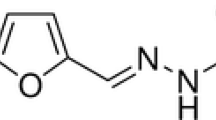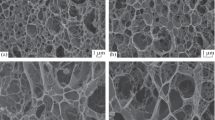Abstract
To develop a gentamicin-loaded wound dressing, cross-linked hydrogel films were prepared with polyvinyl alcohol (PVA) and dextran using the freezing–thawing method. Their gel properties such as gel fraction, swelling, water vapor transmission test, morphology, tensile strength, and thermal property were investigated. In vitro protein adsorption test, in vivo wound healing test, and histopathology were performed. Dextran decreased the gel fraction, maximum strength, and thermal stability of hydrogels. However, it increased the swelling ability, water vapor transmission rate, elasticity, porosity, and protein adsorption. The drug gave a little positive effect on the gel properties of hydrogels. The gentamicin-loaded wound dressing composed of 2.5% PVA, 1.13% dextran, and 0.1% drug was more swellable, flexible, and elastic than that with only PVA because of its cross-linking interaction with PVA. In particular, it could provide an adequate level of moisture and build up the exudates on the wound area. From the in vivo wound healing and histological results, this gentamicin-loaded wound dressing enhanced the healing effect more compared to conventional product because of the potential healing effect of gentamicin. Thus, this gentamicin-loaded wound dressing would be used as a potential wound dressing with excellent forming and improved healing effect in wound care.










Similar content being viewed by others
References
Turner TD. Hospital usage of absorbent dressings. Pharmaceut J. 1979;222:421–4.
Hinman CD, Maibach H. Effect of air exposure and occlusion on experimental human skin wounds. Nature. 1963;200:377–8.
Winter GD. Formation of the scab and the rate of epithelization of superficial wounds in the skin of the young domestic pig. Nature. 1962;193:293–4.
Morin RJ, Tomaselli NL. Interactive dressings and topical agents. Clin Plast Surg. 2007;34:643–58.
Ajji Z, Mirjalili G, Alkhatab A, Dada H. Use of electron beam for the production of hydrogel dressings. Radiat Phys Chem. 2008;77:200–2.
Hoffman AS. Hydrogels for biomedical applications. Adv Drug Deliv Rev. 2002;43:3–12.
Stashak TS, Farstvedt E, Othic A. Update on wound dressings: indications and best use. Clin Tec Equine Pract. 2004;3:148–63.
Valenta C, Auner BG. The use of polymers for dermal and transdermal delivery. Eur J Pharm Biopharm. 2004;58:279–89.
Hassan CM, Stewart JE, Peppas NA. Diffusional characteristics of freeze/thawed poly(vinyl alcohol) hydrogels: applications to protein controlled release from multilaminate devices. Eur J Pharm Biopharm. 2000;49:161–5.
Razzak MT, Darmawan D, Zainuddin S. Irradiation of polyvinyl alcohol and polyvinyl pyrrolidone blended hydrogel for wound dressing. Radiat Phys Chem. 2001;62:107–13.
Yang JM, Su WY, Leu TL, Yang MC. Evaluation of chitosan/PVA blended hydrogel membranes. J Membr Sci. 2004;236:39–51.
Peppas NA. Turbidimetric studies of aqueous poly(vinyl alcohol) solutions. Makromol Chem. 1975;176:3433–40.
Stauffer SR, Peppas NA. Poly(vinyl alcohol) hydrogels prepared by freezing–thawing cyclic processing. Polymer. 1992;33:3932–6.
Kim JO, Park JK, Kim JH, Jin SG, Yong CS, Li DX, et al. Development of polyvinyl alcohol–sodium alginate gel-matrix-based wound dressing system containing nitrofurazone. Int J Pharm. 2008;359:79–86.
Kim JO, Choi JY, Park JK, Kim JH, Jin SG, Chang SW, et al. Development of clindamycin-loaded wound dressing with polyvinyl alcohol and sodium alginate. Biol Pharm Bull. 2008;31:2277–82.
Kim IS, Jeong YI, Kim SH. Self-assembled hydrogel nanoparticles composed of dextran and poly(ethylene glycol) macromer. Int J Pharm. 2000;205:109–16.
Cascone MG, Sim B, Downes S. Blends of synthetic and natural polymers as drug delivery systems for growth hormone. Biomaterials. 1995;16:569–74.
Yeo JH, Lee KG, Kim HC, Oh YL, Kim AJ, Kim SY. The effects of PVA/chitosan/fibroin (PCF)-blended spongy sheets on wound healing in rats. Biol Pharm Bull. 2000;23:1220–3.
Gehrig KA, Warshaw EM. Allergic contact dermatitis to topical antibiotics: epidemiology, responsible allergens, and management. J Am Acad Dermatol. 2008;58:1–21.
Society of Toxicology (SOT) (2008) Guiding principles in the use of animals in toxicology. www.toxicology.org/AI/FA/guidingprinciples.pdf.
Cascone MG, Maltinti S, Barbani N. Effect of chitosan and dextran on the properties of poly(vinyl alcohol) hydrogels. J Mater Sci Mater Med. 1999;10:431–5.
Huang MH, Yang MC. Evaluation of glucan/poly(vinyl alcohol) blend wound dressing using rat models. Int J Pharm. 2008;346:38–46.
Ajji Z, Othman I, Rosiak JM. Production of hydrogel wound dressing using gamma radiation. Nucl Instrum Methods Phys Res: Sect B. 2005;229:375–80.
Yoshii F, Zhanshan Y, Isobe K, Shinozaki K, Makuuchi K. Electron beam cross-linked PEO and PEO/PVA hydrogels for wound dressing. Radiat Phys Chem. 1999;55:133–8.
Yang X, Liu Q, Chen X, Yu F, Zhu Z. Investigation of PVA/ws-chitosan hydrogels prepared by combined γ-irradiation and freeze–thawing. Carbohydr Polym. 2008;73:401–8.
Lin WC, Yu DG, Yang MC. Blood compatibility of novel PGA (poly glutamic acid)/poly vinyl alcohol hydrogels. Colloids Surf B. 2006;47:43–9.
Loh XJ, Sng KBC, Li J. Synthesis and water-swelling of thermo-responsive poly(ester urethane)s containing poly(ε-caprolactone), poly(ethylene glycol) and poly(propylene glycol). Biomaterials. 2008;29:3185–94.
Yoo MK, Kweon HY, Lee KG, Lee HC, Cho CS. Preparation of semi-interpenetrating polymer networks composed of silk fibroin and poloxamer macromer. Int J Biol Macromol. 2004;34:263–70.
Burkatovskaya M, Tegos GP, Swietlik E, Demidova TN, Castano A, Hamblin MR. Use of chitosan bandage to prevent fatal infections developing from highly contaminated wounds in mice. Biomaterials. 2006;27:4157–64.
Kim HJ, Choi EY, Oh JS, Lee HC, Park SS, Cho CS. Possibility of wound dressing using poly(l-leucine)/poly(ethylene glycol)/poly(l-leucine)triblock copolymer. Biomaterials. 2000;21:131–41.
Park SN, Kim JK, Suh H. Evaluation of antibiotic-loaded collagen–hyaluronic acid matrix as a skin substitute. Biomaterials. 2004;25:3689–98.
Quintanilha Ribeiro Fde A, Borges Jde P, Guaraldo L, Vianna MR. Study of wound healing in rats treated with topical and injected mitomycin-C. Rev Bras Otorrinolaringol. 2008;74:328–30.
Hirose K, Onishi H, Sasatsu M, Takeshita K, Kouzuma K, Isowa K, et al. In vivo evaluation of Kumazasa extract and chitosan films containing the extract against deep skin ulcer model in rats. Biol Pharm Bull. 2007;30:2406–11.
Levene A. Pathological factors influencing excision of tumours in the head and neck. Part I. Clin Otalary. 1981;6:145–51.
Ludbrook J. Update: microcomputer statistics packages. A personal view. Clin Exp Pharmacol Physiol. 1997;24:294–6.
Yokoyama F, Masada I, Shimamura K, Ikawa T, Monobe K. Morphology and structure of highly elastic poly(vinyl alcohol) hydrogel prepared by repeated freezing-and-melting. Colloid Polym Sci. 1986;264:595–601.
Choi YS, Hong SR, Lee YM, Song KW, Park MH, Nam YS. Study on gelatin-containing artificial skin: I. Preparation and characteristics of novel gelatin–alginate sponge. Biomaterials. 1999;20:409–17.
Queen D, Gaylor JDS, Evans JH, Courtney JM, Reid WH. The preclinical evaluation of the water vapor transmission rate through burn wound dressings. Biomaterials. 1987;8:367–71.
Kim IY, Yoo MK, Kim BC, Kim SK, Lee HC, Cho CS. Preparation of semi-interpenetrating polymer networks composed of chitosan and poloxamer. Int J Biol Macromol. 2006;38:51–8.
Coleman DL, Gregonis DE, Andrade JD. Blood–materials interactions: the minimum interfacial free energy and the optimum polar/apolar ratio hypothesise. J Biomed Mater Res. 1982;16:381–98.
Dion I, Baquey C, Havlik P, Monties JR. A new model to test platelet adhesion under dynamic conditions. Application to the evaluation of a titanium nitride coating. Int J Artif Organs. 1993;6:545–50.
Evans P. The healing process at cellular level: a review. Physiotherapy. 1980;66:256–9.
Froget S, Barthelemy E, Guillot F, Soler C, Coudert MC, Benbunan M, et al. Wound healing mediator production by human dermal fibroblasts grown within a collagen–GAG matrix for skin repair in humans. Eur Cytokine Netw. 2003;14:60–4.
Martin P. Wound healing—aiming for perfect skin regeneration. Science. 1997;276:75–81.
Risbud M, Hardikar A, Bhonde R. Growth modulation of fibroblasts by chitosan–polyvinyl pyrrolidone hydrogel: implications for wound management. J Biosci Bioeng. 2000;25:25–31.
Sugihara A, Sugiura K, Morita H, Ninagawa T, Tubouchi K, Tobe R, et al. Promotive effects of a silk film on epidermal recovery from full-thickness skin wounds. Proc Soc Exp Biol Med. 2000;225:58–64.
Halper J, Leshin LS, Lewis SJ, Li WI. Wound healing and angiogenic properties of supernatants from Lactobacillus cultures. Exp Biol Med. 2003;228:1329–37.
Acknowledgments
This research was supported by the Regional R&D Cluster Project designated by the Ministry of Science and Technology & the Ministry of Commerce, Industry, and Energy (2009) and a grant from the Korean Health Technology R&D Project, Ministry for Health, Welfare and Family Affairs, Republic of Korea (A092018).
Author information
Authors and Affiliations
Corresponding authors
Rights and permissions
About this article
Cite this article
Hwang, MR., Kim, J.O., Lee, J.H. et al. Gentamicin-Loaded Wound Dressing With Polyvinyl Alcohol/Dextran Hydrogel: Gel Characterization and In Vivo Healing Evaluation. AAPS PharmSciTech 11, 1092–1103 (2010). https://doi.org/10.1208/s12249-010-9474-0
Received:
Accepted:
Published:
Issue Date:
DOI: https://doi.org/10.1208/s12249-010-9474-0




